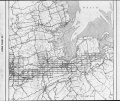Dominion Atlantic Railway Digital Preservation Initiative - Wiki
Use of this site is subject to our Terms & Conditions.
Difference between revisions of "Category:Subdivision Kingsport"
Dan Conlin (talk | contribs) m |
|||
| Line 2: | Line 2: | ||
The Kingsport Subdivision ran 13.6 miles north from [[Kentville]] to [[Kingsport]] and terminating on the large government wharf at Kingsport. In Centreville, at Mile 4.8, the [[:Category:Subdivision Weston|Weston Subdivision]] branched out to the West. | The Kingsport Subdivision ran 13.6 miles north from [[Kentville]] to [[Kingsport]] and terminating on the large government wharf at Kingsport. In Centreville, at Mile 4.8, the [[:Category:Subdivision Weston|Weston Subdivision]] branched out to the West. | ||
==History== | ==History== | ||
| − | The Kingsport subdivision began as an independant company called the Cornwallis Valley Railway (CVR - See also [[:Category:Subdivision Weston|Weston Subdivision]]) which was formed in 1887 by merchants and farmers in [[Canning]]. | + | The Kingsport subdivision began as an independant company called the Cornwallis Valley Railway (CVR - See also [[:Category:Subdivision Weston|Weston Subdivision]]) which was formed in 1887 by merchants and farmers in [[Canning]]. In June 1889 work started on the line and by December 22, 1890, the line started operation leasing rolling stock and terminal facilities from the Windsor and Annapolis Railway in Kentville. It immediately proved profitable and was purchased by the Windsor and Annapolis Railway in 1892, just before the W&A evolved into the Dominion Atlantic. The CVR became a DAR subdivision but train crews and locals used the name CVR for the subdivision until it's final abandonment in the 1990s. |
Running through the richest apple districts of the valley and connecting to steamers and schooners at the [[Kingsport]] wharf, the line enjoyed heavy traffic in its first decades, running six trains a day in World War One. It also served as a suburban railway for the greater Kentville area, bringing school children, shoppers and workers to town in the morning and back home at night. However the collapse of the apple industry after 1945 and the growth of paved roads eroded traffic in the 1950s. After several years of application, the DAR abandoned most of the subdivision. | Running through the richest apple districts of the valley and connecting to steamers and schooners at the [[Kingsport]] wharf, the line enjoyed heavy traffic in its first decades, running six trains a day in World War One. It also served as a suburban railway for the greater Kentville area, bringing school children, shoppers and workers to town in the morning and back home at night. However the collapse of the apple industry after 1945 and the growth of paved roads eroded traffic in the 1950s. After several years of application, the DAR abandoned most of the subdivision. | ||
Revision as of 15:10, 16 June 2008
Kingsport Subdivision, "The Cornwallis Valley Railway"
The Kingsport Subdivision ran 13.6 miles north from Kentville to Kingsport and terminating on the large government wharf at Kingsport. In Centreville, at Mile 4.8, the Weston Subdivision branched out to the West.
History
The Kingsport subdivision began as an independant company called the Cornwallis Valley Railway (CVR - See also Weston Subdivision) which was formed in 1887 by merchants and farmers in Canning. In June 1889 work started on the line and by December 22, 1890, the line started operation leasing rolling stock and terminal facilities from the Windsor and Annapolis Railway in Kentville. It immediately proved profitable and was purchased by the Windsor and Annapolis Railway in 1892, just before the W&A evolved into the Dominion Atlantic. The CVR became a DAR subdivision but train crews and locals used the name CVR for the subdivision until it's final abandonment in the 1990s.
Running through the richest apple districts of the valley and connecting to steamers and schooners at the Kingsport wharf, the line enjoyed heavy traffic in its first decades, running six trains a day in World War One. It also served as a suburban railway for the greater Kentville area, bringing school children, shoppers and workers to town in the morning and back home at night. However the collapse of the apple industry after 1945 and the growth of paved roads eroded traffic in the 1950s. After several years of application, the DAR abandoned most of the subdivision.
Tracks north of Mill Village (Steam Mill) at Mile 2.2 to Kingsport and Weston were abandoned on January 31, 1961. The remnant of the subdivision became Spur Track D of the DAR serving Camp Aldershot and the feed mill and fertilizer plant at Mill Village.
On September 22, 1993, CP Rail formally abandoned its tracks from New Minas (mileage 52.9) to Kentville, including the remaining 2.3 mile Spur Track D from mileage 56.1 of the Halifax Subdivision to the end of track in Mill Village (Steam Mill).
Gallery
The Kingsport Train crosses the Cornwallis River Bridge at Mile .23 of the Kingsport Subdivision in 1956.
Train No. 14 traversing the last few hundred feet of the CVR arriving at Kentville from Kingsport led by No. 470. . August 1949.
References and Footnotes
- Dominion Atlantic Railway Timetable June 29, 1914, Nova Scotia Archives and Records Management, VF Vol.1 #5.
- Dominion Atlantic Railway Employeed Timetable September 25, 1949, Library and Archives Canada, pmp -HE.2804 DC
- Marguerite Woodworth, History of the Dominion Atlantic Railway, 1937, p. 104-107.
External Links
- Ivan Smith's History of the CVR at ROCA.
- http://alts.net/ns1625/railways.html
- http://www.alts.net/ns1625/railwy05.html
Locations
Locations categorised below under "D" are on the Kentville to Centreville leg (north). Locations categorised under "K" are on the Centreville to Kingsport leg (east).
Pages in category "Subdivision Kingsport"
The following 17 pages are in this category, out of 17 total.



